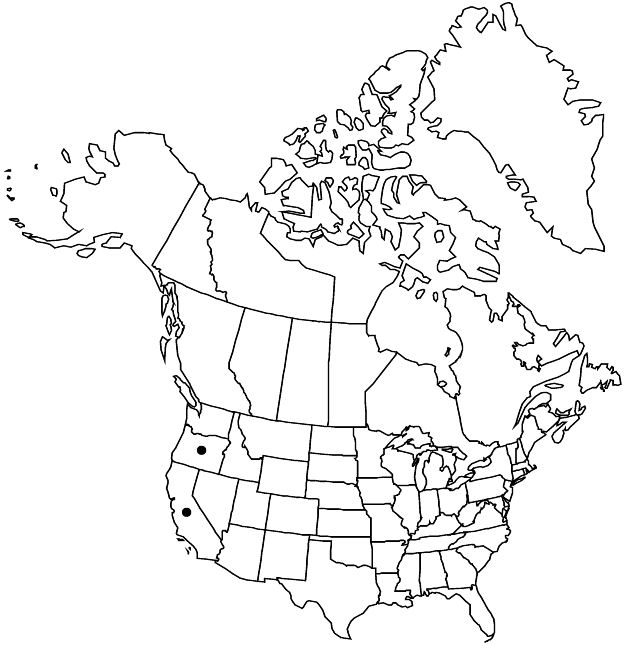Horkelia tridentata
in War Department [U.S.], Pacif. Railr. Rep. 4(5): 84, plate 6. 1857.
Plants mostly rosette-forming, grayish. Stems decumbent to nearly erect, 0.5–4 (–7) dm, hairs 1–3 mm proximally, glands absent or sparse distally. Basal leaves planar, 3–12 × 1–3 (–4) cm, usually sericeous to villous, sometimes glabrate adaxially; stipules entire or rarely forked or pectinate; leaflets 2–5 (or 6) per side, separate to slightly overlapping, elliptic to cuneate-oblong, (3–) 5–20 (–30) × 1.5–7 (–10) mm, (1/4–) 1/3–1/2 as wide as long, divided 1/10–1/6 or less to midrib into (0–) 3 (or 4) triangular teeth 1 mm wide, these restricted to apex. Cauline leaves 1–5; stipules 3–12 mm, entire or deeply 3–5-lobed, lanceolate to ovate. Inflorescences open to congested, flowers arranged in ± capitate glomerules or in ± corymbiform clusters. Pedicels (1–) 2–6 (–10) mm. Flowers 4–10 mm diam.; epicalyx bractlets linear to narrowly elliptic, 0.8–2 (–3) × 0.2–0.4 mm, 1/2–2/3 length of sepals; hypanthium 1–2.5 × 2–5 mm, 1/2 to nearly as deep as wide, interior glabrous or pilose; sepals moderately reflexed, abaxially green to reddish, 1.5–3 mm; petals white, sometimes tinged with pink, linear to broadly oblanceolate, (1–) 1.5–4 (–4.5) × 0.3–1.5 mm, apex acute to rounded or mucronate; filaments 0.5–2 × 0.1–0.4 (–0.8) mm, anthers 0.2–0.5 mm; carpels 5–15; styles 1–2.5 mm. Achenes light-brown, 1.5–2.5 mm, rugose.
Distribution

Calif., Oreg.
Discussion
Varieties 2 (2 in the flora).
Rydberg established Horkelia flavescens on the basis of its more congested inflorescence, purportedly yellowish petals, and broader filaments. As noted by D. D. Keck (1938), the petals are usually white, at least when fresh, and the other characters are highly variable; he reduced H. flavescens to a subspecies of H. tridentata, which is here treated at the rank of variety. In general, var. flavescens tends to be more decumbent with a single, loosely congested flower cluster and broader petals; these characters completely overlap and can vary independently. The presence or absence of hairs on the hypanthium interior is the single most reliably diagnostic character and is the primary determiner of the geographic distributions presented here. The exception is a cluster of populations from the extreme southern end of the coastal range of var. flavescens in Colusa, Lake, and Mendocino counties, California, which have glabrous hypanthia but otherwise have all the diagnostic characters of var. flavescens. Although provisionally included here within var. flavescens, these populations may be better treated as a separate variety.
Selected References
None.
Key
| 1 | Hypanthium interior glabrous; petals linear to oblanceolate, usually ± equal to or longer than sepals; inflorescences composed of 1+ ± capitate glomerules, these sometimes expanding with age. | Horkelia tridentata var. tridentata |
| 1 | Hypanthium interior pilose (except in some North Coast Ranges of California); petals ± broadly oblanceolate, often shorter than sepals; inflorescences composed of usually 1 ± corymbiform cluster. | Horkelia tridentata var. flavescens |
"thin" is not a number."/2lengthofsepals" is not declared as a valid unit of measurement for this property."dm" is not declared as a valid unit of measurement for this property."dm" is not declared as a valid unit of measurement for this property."dm" is not declared as a valid unit of measurement for this property.